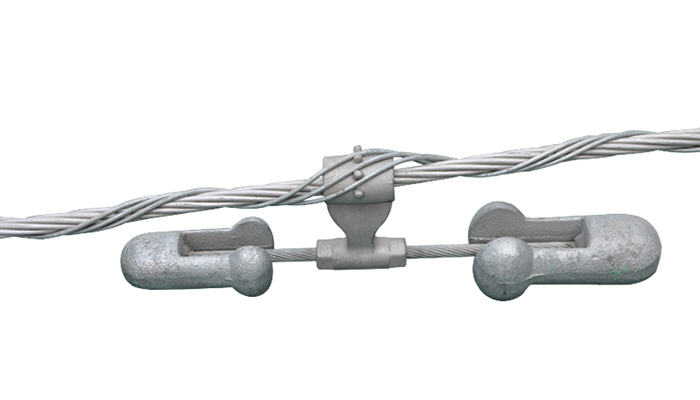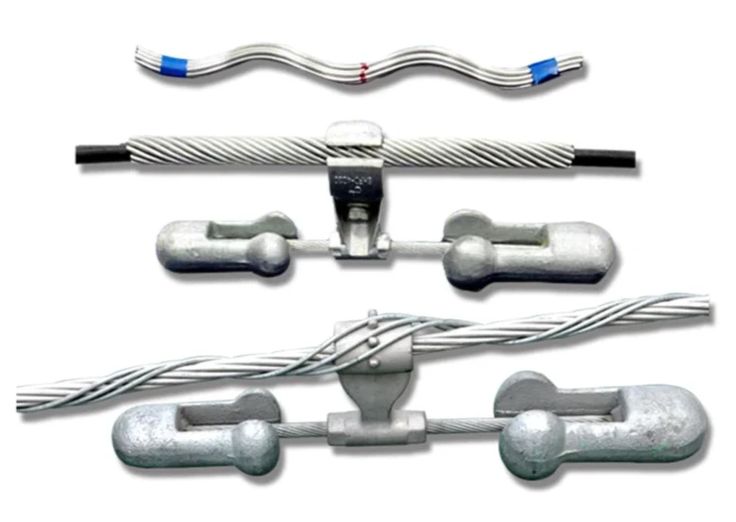
Armor rod is a device used promote the mechanical strength and durability of the conductor in transmission lines. It aids in protecting the conductor from vibration, abrasion and wear from wind, ice and other factors. It is also known as rod armor or armour rod. Armor rod protects the conductors against bending, compression, abrasion or flashovers. The components are from a wide range of materials such as aluminum alloy, steel or galvanized steel. The rods install by wrapping around the conductor to provide support and various points along the line. They also have various coatings such as Epoxy, polyethylene or PVC. Armor rods are available in a variety of sizes to fit different conductor sizes. Use of armor rods contributes to safety, reliability and longevity of the infrastructure.
Common materials used in the manufacture of armor rod
There are various types of materials that aid in the making of the armor rods. The materials contribute to the safety, durability and longevity of the armor rod. The choice of material depends on factors such as specific application, environmental conditions and the properties required for effective protection. Each material used for armor rod has its specific advantages and disadvantages. The selected material should ensure the continued performance of armor rods in the application. The following are the materials for armor rods.

- Aluminum – this is the most popular choice for armor rods due to its lightweight characteristics. It also has the ability to resist corrosion and increase conductivity. Aluminum armor rods provide effective protection to conductors. Aluminum materials are durable and cost effective.
- Aluminum-clad steel – this is the material that combines the benefits of aluminum and steel. the aluminum part provides corrosion resistance and conductivity. The inner core is from steel which offers strength and durability.
- Stainless steel – stainless steel armor rods are less common due to their high costs. They help in areas with extreme environmental conditions to enhance durability.
- Galvanized steel – galvanized steel armor rods provide strength and corrosion resistance. The galvanized steel rods contain a layer of zinc which adds an extra layer of protection against rust and other elements.
- Composite materials – this includes a combination of fiberglass, epoxy and other polymers. Armor rods from these materials provide high strength, lightweight and resistance to environmental conditions.
Various types of armor rod
There are various types of armor rods that meet the specific requirements of various applications. The choice of armor rod depends on factors such as the type of conductor, environmental conditions and the application. Additionally, it is advisable to consult with industry professionals for guidance on the best type for your application. The following are the various types of armor rods.

- Helical armor rods – these are spiral-shaped rods that wrap around the conductor in helical pattern. This helps them to provide effective protection against vibrations and abrasion.
- Preformed armor rods – these armor rods are available in various shapes that help increase reliability and protection.
- Compression armor rods – these are armor rods designed to absorb and distribute compressive forces on the conductor. It adds extra layer of protection against mechanical stress.
- Composite armor rods – these are rods made from materials like epoxy, fiberglass and other polymers. They offer a balance of strength, light weight and resistance to environmental conditions.
- Suspension armor rods – these are rods that prevent abrasion and damage to conductors in areas with high winds and ice.
- Spacer damper armor rods – these are rods that serve a dual purpose by spacing the conductors and reducing vibrations.
Factors to consider when selecting the size of an armor rod
Proper selection of the size helps to ensure optimal protection and performance on your overhead lines. there are several factors that influence the selection of armor rod size. The right size also contributes to the resilience and reliability of overhead lines. additionally, it is advisable to seek professional help to select the best size for your specific needs. The following are the factors to consider when selecting armor rod sizes.

- Conductor diameter – this is the primary factor to consider when selecting armor rods. Correct size ensures the rod fits the conductor and ensure efficient stress distribution. Always consult the manufacturers size chart for compatible armor rod options.
- Protection needed – consider the specific threats and environmental challenges for conductor’s face. Select larger armor rod with thick coatings for areas with strong winds or heavy ice accumulation.
- Installation feasibility – ensure the selected size allows for practical installation on your specific type of tower. Also, consider the available tools for handling the selected armor rod size.
- Costs – balance the cost and protection of the armor rod for increased efficiency. Selecting large armor rods provide protection but they are costly and may need extra installation resources.
- Manufacturer specifications – follow manufacturers guidelines that offer detailed size charts and compatibility information.
- Type of armor rod – different types of armor rods have different size ranges and functionalities. Each armor rod type offers protection according to conductor diameters.
Classification of armor rods
Armor rods classify depending on various focus points. The classification depends on features, materials and intended use of the armor rod. The classifications may be by applications, material, function and number of helical features. Understanding the classifications helps to select the right type for your specific needs. It also helps to ensure optimal performance and protection for your overhead lines. The following are the various classifications for armor rods.

- Application – armor rods classify according to the specific demands of high voltage lines. There are other rods that are suitable for distribution lines with lower voltage levels. The armor rods should also provide extra support for conductors on guyed towers and self-supporting towers.
- Function – armor rods may classify into preformed armor rods, repair armor rods, connection repair rods and spacer dampers. These may help in repairing minor damage or extreme damage to conductors to restore functionality. They also help in reducing movement and vibration. This also leads to reduced fatigue and wear of the conductors.
- Material – the rods may classify according to material such as aluminum alloy, galvanized steel or composite materials. Each of the material has different benefits such as lightweight, corrosion resistant, strength and weather resistance.
- Number of helical wires – the number of the wires vary depending on the size and intended use of armor rod.
- Installation features – some of the armor rods have features like crimping sleeves for easier and faster installation.
Features to check when selecting armor rods
Proper selection of armor rods requires careful consideration of various factors and features. This is to ensure the optimal protection for your overhead lines. Some of the key features to check is the material, size and type of armor rod. There are however other features to look for when selecting the rods. Also, selecting the right armor rods protects the infrastructure and ensure the smooth flow of electricity. The following are the features to look for when selecting armor rods.

- Coating – some of the rods come in various coatings for extra defence against mechanical stresses. The coating materials include PVC, epoxy or polyethylene. These coatings provide electrical insulation, UV protection, abrasion resistance and chemical resistance.
- Strength and durability – consider the load baring capacity of the armor rod in relation to conductor size. Select materials like galvanized steel for heavy conductors.
- Preformed shape – the pre-formed rods fit onto the conductor. This facilitates to smooth installation and ensures proper contact for effective protection.
- Crimping sleeves – check this feature which makes installation faster and simpler. Check for secure and durable mechanisms that withstand long-term stress.
- Corrosion resistance – select materials and coatings with corrosion resistance to reduce maintenance needs. This also help to extend the lifespan of the armor rod.
- Cost effectiveness – consider the balance between protection of the rods and their costs. Some of the premium materials may be costly than others.
- Manufacturer – check the reputation and expertise of the manufacturer for quality assurance and reliable performance.
- Compatibility – ensure the selected armor rod is compatible with your specific conductor type and existing infrastructure.
- Helical wires – the spiral design of the rod provides gripping power and distributes stress evenly around the conductor. Check for the number and thickness of wires to increase protection.
Frequently asked questions
The size of the armor rod ensures their effectiveness in various applications. The size of the rod may impact the ability to provide protection to conductors. It also helps to ensure the effective distribution of mechanical forces.
The safe installation of armor rods requires the use of various tools such as wrenches, rope cutters, tape measure. Insulating gloves and toolbox.
Armor rods enhance the efficiency and reliability of the power grid through prevention of conductor damage, enhanced mechanical strength, reduced power outages, improved system resilience and cost savings.
Ensuring proper installation and maintenance of armor rods helps to prevent accidents, protect personnel and maintain the reliability of overhead transmission lines.